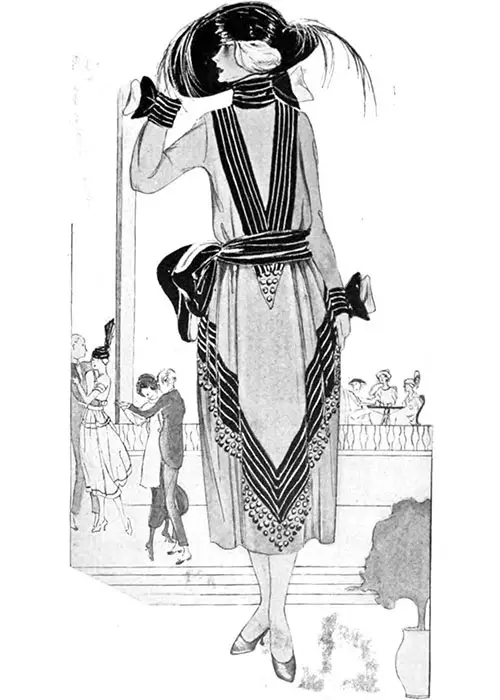House of Jenny - Parisian Fashion Design Firm - 1920

Dress of kashavella, trimmed with bands of wared satin and wooden beads.
Use of Braid and Fur Trimming, Combined with Simplicity and Unity of Color, Distinguish Many Attractive Models.
Simplicity and great unity of color and design, mark the creations of Mme. Jenny. The entire collection presents a straight unbroken silhouette, very chic and plain but for the various embroideries; the craze for rich, elaborate trimmings is present everywhere, and we may congratulate the Parisian dressmakers on the ingenuity displayed to make them different.
The tailor-mades run in sober colors, black, greys, blues and blue and red; mouflon, duvetyn and much velvet are the leading stuffs. The skirts sometimes have a few pleats at the sides, and in one instance, a pleated apron is worn over a plain sheath.
Coats are short, almost boléros, medium-long but always straight and not too loose; the collars are mostly high, turned over or not and may finish off in a double loop at the side; then we have scarf collars thrown over one shoulder made of rows of mouflon fur; there are also examples of shawl revers, very loose and low.
When the collar has a loop, the coat fastens down the left under embroidery, fine red silk soutache for instance, on bright blue velvet. We notice low, loose belts of ribbon and metal or just a jeweled clasp at the waist in front.
Tailleurs are often edged and bordered by a narrow band of fur. Mouflon (Thibetan goat) is used in preference to monkey; a black duvetyn suit, very chic and simple, has a vest and collar of grey squirrel; lamb and Agnella, its substitute, make good trimmings and collars; a fawn suit is edged coat and skirt by incrusted squares of broadtail; another trimming is tiny strips of fur caught into braid several rows deep.
For Jenny is extremely fond of braid—the narrow black silk variety, soutached into geometrical designs, or as in the case of a grey boléro, bordered in black design.
A smart black velvet suit, the jacket rather below medium length, is much braided, a wide green band is let in at the hip level, and the large shawl collar fastens just above the green and silver jeweled belt clasp.
The list of coats opens with a chic cinnamon-brown blanket traveling coat lined with bright blue, the lining supplying the revers when the wrap is thrown open.
For a change on a black coat, the wide pagoda sleeves form a cape front instead of the already popular cape back. A smart cape coat of beige duvetyn is edged with row after row of narrow skunk bands.
The evening wraps are highly fanciful; one cape shapes right up to the chin without the aid of a collar, ties in front by a large batik ribbon bow; another coat with a deep fur yoke is brocade, embroidered and traced over in bold red and gold much in relief, like a tapestry.
All the dresses present the straight line; apart from narrow panels and detached aprons we have the perfectly flat frock, the high turned over collar and sash in contrasting materials; a black serge coat-dress striped in silk braid has a nasturtium crepe de Chine sash and collar lined with the same.
For sashes are plentiful here; knotted loosely to one side, a lovely grey velvet trimmed with squirrel has a grey satin bow. Then again, a dark sheath is slashed into long slits at the waist revealing a bright lining. Sometimes we find these tight sheaths open to one side and fold back showing braiding (yes, there is lots of it on dresses too) or embroidery underneath.
A new and pretty interpretation of the sheath is to wrinkle it in lateral folds around the figure from waist to knee. A beige velvet model has each wrinkle fastened by a button on the left side and a high fur collar tied by a velvet bow.
There are frequent combinations of low waisted turquoise or jade velvet bodices embroidered and worn over black skirts, tiny streamers or loops from the blouse connecting the two colors.
An embroidery of childish simplicity and would-be carelessness is of thick beige wool in the ordinary “run” stitch forming a yoke of rows of "piqures"on a black crepe marocain.
Georgette in rust brown, Persian blue, orange, and nègre makes delightful rather less clinging afternoon gowns, the light floating panels weighted down by soutache, chain stitch or again braid!
Yellow and light blue chiffon, combined and superposed, gives beautiful changing reflections especially by artificial light, for these sheer dresses are to be worn informally in the evening.
Formal evening dress is quite conservative, showing the same tight lines, often wrinkled (one can hardly call it draping, it is so very slight) up a little to the side; the waistline is very low and further accentuated by the frequent use of broad, loose sashes, the ends trailing on the ground; the neckline is square with tiny shoulder straps; very often these low bodices, a single fold of bright ribbon, are veiled to the neck by straight net or lace panels.
"Dorat" in the Garment Manufacturers’ Index, New York: The Allen-Nugent Co. Publishers, Vol. II, No. 2, September 1920: 28.
